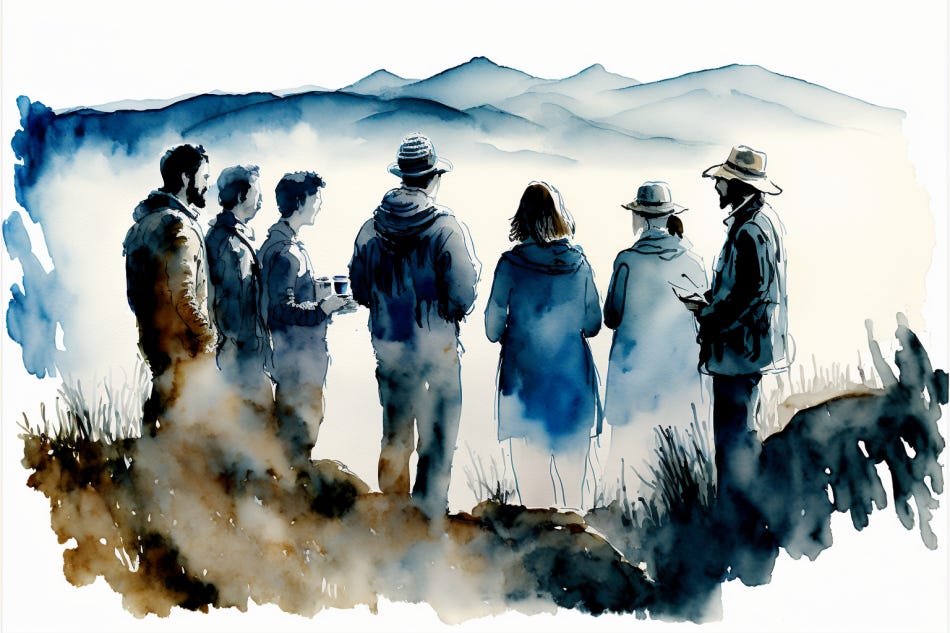This Is Common Appalachian
Common Appalachian envisions Southern Appalachia as a distinct cultural area and bioregion devoted to communitarian values.
MORGANTON, North Carolina—In the inaugural entry for Common Appalachian, it’s customary to let readers in on what exactly it is I’m trying to do here.
It’s no secret there’s a dearth of compelling stories being written about our community, what we value, who we are, and what matters to us.
I’m referring specifically to Morganton, North Carolina, which will be the core of Common Appalachian because that is where I’m personally rooted, alongside my wife, our two German shepherds, two barn cats, two Alaskan rabbits, and a corn snake (which seems more like an active decoration than a pet to me).
Morganton is my town, my home (although I actually live several minutes outside our charming municipality, on a small sliver of Eden I’m trying to steward and regenerate).
Cultural & Political Happenings in Southern Appalachia
Nonetheless, Common Appalachian will cover cultural and political happenings in Greater Burke County, the Foothills of the Blue Ridge Mountains, Southern Appalachia, and likely even touch on topics relevant to our brothers and sisters in the more northerly hollers and hills of Appalachia.
In an age where many of us are rootless, deracinated, or distracted by things happening elsewhere, I want to encourage more people to focus locally, love this place, and care for it.
In a word, I want to give us more reasons to center our attention on Southern Appalachia, the challenges we encounter in our tangible communities (you know, the places we live in), rather than allow ourselves to get caught up in the toxic rhetoric and power struggles in far way places (those realms beyond Appalachia).
Those are places where we typically have very little impact on what actually happens. And, truthfully, I think most of us feel less and less represented by seats of power and mass culture the further away they are from the Blue Ridge.
Our Communitarian Values
In the spirit of contributing to the community, Common Appalachian aims to share our stories and highlight the cultural values we want to see rooted and reflected in our region.
Common Appalachian will help shape and embody a vision of Southern Appalachia as a distinct cultural area and bioregion devoted to the communitarian values many of us hold dear.
Put another way, Common Appalachian is dedicated to social change rooted in Southern Appalachian community.
Community Is Local, Concrete
There’s a common saying among localists: “It’s easy to love humanity, but it’s hard to love your individual neighbors.” This is the ethos of Common Appalachian.
It’s little skin off your back or mine to express support for greater tolerance, reducing human suffering, combatting habitat destruction, or eradicating poverty. But it’s an entirely different matter when we’re doing something concrete in our local community, our eyes focused on the here, not what’s out there, beyond our bioregion.
Greater tolerance in our community looks like Adventure Bound Books displaying an inclusive rainbow flag proudly on their wall, next to the many tomes and volumes that inspire us toward active empathy and greater awareness of the challenges marginalized people still face in Southern Appalachia (and, yes, other places abroad). Owner Angela Shore has established an incredibly inviting and supportive institution in our community.
Reducing human suffering looks like the free food pantry Grace Episcopal Church keeps stocked for people in need or for those experiencing homelessness. I don’t think I’ve ever seen it empty.
Combatting habitat destruction looks like the more than 65,000 acres of land acquired and permanently protected by the Foothills Nature Conservancy, including a 652-acre acquisition, Oak Hill Community Park and Forest, which is expected to open in late 2023. Their work is vital to the health of our water, forests, and community (human and non-human animals alike).
Eradicating poverty looks like the worker-owned coops and social enterprises supported by The Industrial Commons aimed to rebuild a “diverse working class based on locally rooted wealth.” They are fueled by an intense passion for improving the material lives of people in Southern Appalachia, a region well-acquainted with poverty.
These are just a few of the amazing things happening in our region. I want to hear about more of them. Common Appalachian wants to write about more of them.
This reflects what many of us want to see in our particular cultural region. These are the types of movements that have a deep history in Appalachia (as we’ll cover more in subsequent entries and stories).
A Front Porch, A Pew, A Town Square, A Town Bulletin
Common Appalachian is, I hope, a bit like a front porch where we can talk about what’s happening in our community and wave to our friends.
It’s a pew on Sunday where we can discuss better ways to help our ailing neighbors down the road.
It’s a town square where we can debate the changes we want to see or better address the problems troubling the Foothills.
It’s a town bulletin where we showcase what matters to us and what it means to be Appalachian in the twenty-first century.
And, of course, I’m sure Common Appalachian will become many other things.
For now, greetings and thank you for letting me be part of Southern Appalachia. I hope it can be something you’ll look forward to reading and be proud to share with your family, neighbors, and friends as we work together to foster the type of community we want to live in.


